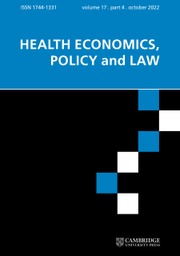Crossref Citations
This article has been cited by the following publications. This list is generated based on data provided by
Crossref.
Genuis, Stephen J.
and
Lipp, Chris
2013.
Ethical Diversity and the Role of Conscience in Clinical Medicine.
International Journal of Family Medicine,
Vol. 2013,
Issue. ,
p.
1.
Gusmano, Michael K.
2014.
Is It Reasonable to Deny Older Patients Treatment for Glioblastoma?.
Journal of Law, Medicine & Ethics,
Vol. 42,
Issue. 2,
p.
183.
Leclerc, Bernard-Simon
Lessard, Sabrina
Bechennec, Coralie
Le Gal, Emma
Benoit, Sylvie
and
Bellerose, Lyne
2014.
Attitudes Toward Death, Dying, End-of-Life Palliative Care, and Interdisciplinary Practice in Long Term Care Workers.
Journal of the American Medical Directors Association,
Vol. 15,
Issue. 3,
p.
207.
Mitoku, Kazuko
and
Shimanouchi , Setsu
2014.
The Decision-Making and Communication Capacities of Older Adults with Dementia: A Population-Based Study.
The Open Nursing Journal,
Vol. 8,
Issue. 1,
p.
17.
van den Dungen, Pim
Moll van Charante, Eric P.
van de Ven, Peter M.
Foppes, Gerbrand
van Campen, Jos P. C. M.
van Marwijk, Harm W. J.
van der Horst, Henriëtte E.
and
van Hout, Hein P. J.
2015.
Dutch family physicians’ awareness of cognitive impairment among the elderly.
BMC Geriatrics,
Vol. 15,
Issue. 1,
Nakanishi, Miharu
Nakashima, Taeko
Shindo, Yumi
Miyamoto, Yuki
Gove, Dianne
Radbruch, Lukas
and
van der Steen, Jenny T.
2015.
An evaluation of palliative care contents in national dementia strategies in reference to the European Association for Palliative Care white paper.
International Psychogeriatrics,
Vol. 27,
Issue. 9,
p.
1551.
Mahin-Babaei, Fariba
Hilal, Jamal
and
Hughes, Julian C.
2016.
The basis, ethics and provision of palliative care for dementia: A review.
Maturitas,
Vol. 83,
Issue. ,
p.
3.
Maschke, Karen J.
and
Gusmano, Michael K.
2017.
Medicare and Amyloid PET Imaging: The Battle Over Evidence.
Journal of Aging & Social Policy,
Vol. 29,
Issue. 2,
p.
105.
Sloane, Philip D.
Zimmerman, Sheryl
and
Boustani, Malaz
2018.
The Unmet Promise of a Miracle Drug for Alzheimer's Disease: Implications for Practice, Policy, and Research.
Journal of the American Medical Directors Association,
Vol. 19,
Issue. 7,
p.
557.
Slyer, Jason T.
Archibald, Ella
Moyo, Fernea
and
Truglio-Londrigan, Marie
2018.
Advance care planning and anticipatory decision making in patients with Alzheimer disease.
The Nurse Practitioner,
Vol. 43,
Issue. 6,
p.
23.
Hill, Emily
Savundranayagam, Marie Y.
Zecevic, Aleksandra
and
Kloseck, Marita
2018.
Staff Perspectives of Barriers to Access and Delivery of Palliative Care for Persons With Dementia in Long-Term Care.
American Journal of Alzheimer's Disease & Other Dementiasr,
Vol. 33,
Issue. 5,
p.
284.
Cresp, Sarah Jane
Lee, Susan Fiona
and
Moss, Cheryle
2020.
Substitute decision makers’ experiences of making decisions at end of life for older persons with dementia: A systematic review and qualitative meta-synthesis.
Dementia,
Vol. 19,
Issue. 5,
p.
1532.




